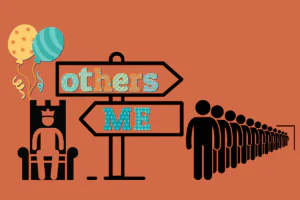Guest blog by Holly Miller, MA, LPC
In any meaningful relationship boundaries are essential. This is the case for romantic relationships, familial relationships, friendship, or professional relationships. They’re not walls to keep others out, but rather doors that define where you end and another person begins. Despite this, one of the most common questions people ask in therapy is:“How do I balance my needs with the needs of others?” That question speaks to the very heart of boundary work. Let’s unpack how to create healthy boundaries, what happens when they’re not present, and how to practice mutual respect without losing sight of yourself.
What Are Unhealthy Relationship Boundaries?
Before we dive into how to build healthy ones, it’s important to recognize what unhealthy relationship boundaries look like.
Some characteristics of unhealthy boundaries are:
- Too rigid, cutting you off from emotional intimacy or making it hard to accept help from others
- Too porous, meaning you say “yes” when you mean “no,” absorb others’ emotions, or feel responsible for their happiness
- Nonexistent, which often looks like chronic people-pleasing, fear of conflict, or difficulty asserting your needs
In unhealthy dynamics, one person’s needs consistently take precedence over the other’s. You may feel drained, resentful, or unsure where you stand in the relationship. That internal friction is often a signal that a boundary is needed.
Related: Building Connection and Bonding in Your Relationship
Why Are Relationship Boundaries Important?
Boundaries in relationships aren’t just about keeping others in check. They’re about preserving your sense of self.
They allow you to protect your emotional well-being, say no without guilt, communicate with clarity and honesty, and maintain mutual respect.
Without clear boundaries, it’s easy to lose sight of your own identity and fall into cycles of burnout, resentment, or emotional enmeshment. Whether you’re the one always accommodating or the one who struggles to tolerate another’s “no,” the absence of healthy boundaries can fracture connection over time.
Types of Boundaries in Relationships
There are many ways to define and protect your needs, depending on the nature of the relationship. Several types of boundaries in relationships that everyone should consider are:
- Physical Boundaries- Relating to your personal space and physical touch. This includes things like needing space when you’re upset, or deciding who you’re comfortable hugging.
- Emotional Boundaries– Protect your ability to feel your feelings without having to absorb someone else’s. Emotional boundaries help you separate your emotional experience from others’ projections or blame.
- Time Boundaries– Guard how much time you give to others and ensure you have enough left for rest, self-care, or personal goals.
- Mental Boundaries– Allow you to have your own thoughts, beliefs, and opinions, even when they differ from someone else’s. Mental boundaries are essential for respectful disagreement.
- Material Boundaries– Relate to your possessions and finances. Who can borrow what? What are you comfortable sharing?
- Sexual Boundaries– Define your preferences, limits, and consent in intimate relationships. These require consistent communication and mutual agreement.
Each type matters. Together, they form a map of how you move through relationships with self-respect and mutual care.
How to Start Setting Healthy Boundaries
Setting boundaries isn’t just a one-time conversation. It’s an ongoing practice that begins with self-awareness.
Here’s a practical path you can follow:
Balancing Your Needs with the Needs of Others
This is where things get nuanced. Boundaries aren’t meant to cut you off from others. They’re meant to strengthen connection through mutual respect. Some principles to help you walk that balance are:
- Recognize interdependence, not codependence
In healthy relationships, your needs matter just as much as the other person’s. You can support someone without sacrificing yourself. - Practice empathy without self-abandonment
You can listen deeply and care for others’ emotions while also honoring your own limits. Compassion doesn’t require self-erasure. - Negotiate, don’t bulldoze
Sometimes two people’s needs will conflict. The goal isn’t for one to win, but to collaborate. Ask, “What can we both live with?” rather than “Who’s right?” - Check in with yourself regularly
Are you feeling resentful? Burned out? Disconnected from your own values? These may be signs that your boundaries need tuning. - Remember that healthy boundaries benefit others
You may worry that setting a limit will hurt someone. Boundaries actually foster clarity, emotional safety, and trust. When people know where you stand, they feel safer around you.
Boundaries are acts of care not just for you, but for the health of your relationships.
Help with Setting Boundaries
If you’ve been asking,“How do I balance my needs with the needs of others?”, remember that the answer doesn’t lie in giving up your needs to keep the peace, nor in dismissing others to assert your autonomy. It lies in being honest with yourself, clear with others, and compassionate with both. Setting boundaries takes practice, especially if you grew up in an environment where boundaries weren’t modeled or respected. But every step you take toward naming and honoring your limits is a step toward freedom, authenticity, and deeper connection.
The relationships that thrive are the ones where everyone gets to be whole. And that includes you. Therapists at Life Care Wellness can help you get started with setting boundaries. Please contact us so we can meet with you at our Glen Ellyn, Chicago (Jefferson Park), or Sycamore offices or by telehealth.
Holly takes a special interest in working with young adults, neurodivergence, trauma, family-of-origin issues, and multicultural experiences. She adopts a relational approach and focuses on increasing clients’ awareness of themselves. She also likes to look beyond personal issues and try to find generational patterns or systematic roots. Holly sees clients in the Glen Ellyn office.






